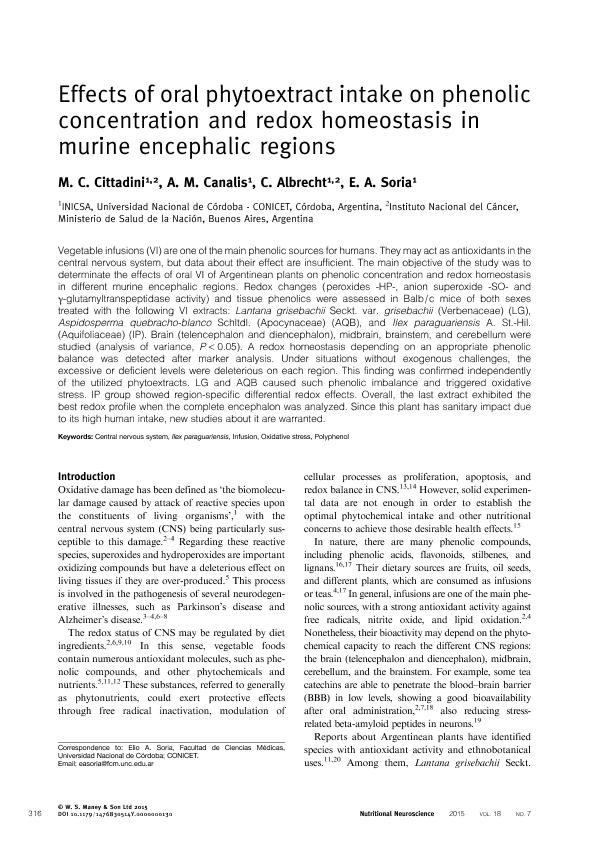Artículo
Effects of oral phytoextract intake on phenolic concentration and redox homeostasis in murine encephalic regions
Fecha de publicación:
10/2015
Editorial:
Maney Publishing
Revista:
Nutritional Neuroscience
ISSN:
1028-415X
e-ISSN:
1476-8305
Idioma:
Inglés
Tipo de recurso:
Artículo publicado
Clasificación temática:
Resumen
Vegetable infusions (VI) are one of the main phenolic sources for humans. They may act as antioxidants in the central nervous system, but data about their effect are insufficient. The main objective of the study was to determinate the effects of oral VI of Argentinean plants on phenolic concentration and redox homeostasis in different murine encephalic regions. Redox changes (peroxides -HP-, anion superoxide -SO- and γ-glutamyltranspeptidase activity) and tissue phenolics were assessed in Balb/c mice of both sexes treated with the following VI extracts: Lantana grisebachii Seckt. var. grisebachii (Verbenaceae) (LG), Aspidosperma quebracho-blanco Schltdl. (Apocynaceae) (AQB), and Ilex paraguariensis A. St.-Hil. (Aquifoliaceae) (IP). Brain (telencephalon and diencephalon), midbrain, brainstem, and cerebellum were studied (analysis of variance, P < 0.05). A redox homeostasis depending on an appropriate phenolic balance was detected after marker analysis. Under situations without exogenous challenges, the excessive or deficient levels were deleterious on each region. This finding was confirmed independently of the utilized phytoextracts. LG and AQB caused such phenolic imbalance and triggered oxidative stress. IP group showed region-specific differential redox effects. Overall, the last extract exhibited the best redox profile when the complete encephalon was analyzed. Since this plant has sanitary impact due to its high human intake, new studies about it are warranted.
Archivos asociados
Licencia
Identificadores
Colecciones
Articulos(INICSA)
Articulos de INSTITUTO DE INVESTIGACIONES EN CIENCIAS DE LA SALUD
Articulos de INSTITUTO DE INVESTIGACIONES EN CIENCIAS DE LA SALUD
Citación
Cittadini, María Cecilia; Canalis, Alejandra Mariel; Albrecht, Claudia; Soria, Elio Andres; Effects of oral phytoextract intake on phenolic concentration and redox homeostasis in murine encephalic regions; Maney Publishing; Nutritional Neuroscience; 18; 7; 10-2015; 316-322
Compartir
Altmétricas




